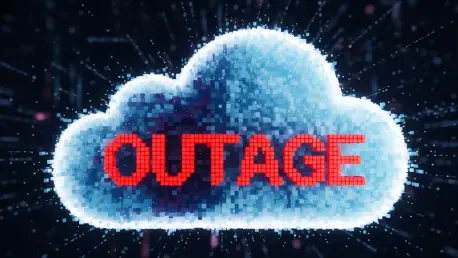Imagine a single glitch halting access to essential online services like messaging apps, streaming platforms, and social media for millions of users worldwide, creating chaos in an instant. This scenario unfolded on a Tuesday morning when a major internet infrastructure provider experienced a significant outage, disrupting platforms such as ChatGPT, Spotify, and X. The incident affected a vast swath of the digital ecosystem, raising urgent questions about the stability of the web. This roundup gathers insights, opinions, and recommendations from various industry voices to unpack the causes, impacts, and lessons from this disruption, aiming to shed light on the internet’s vulnerability and the path toward greater resilience.
Diverse Perspectives on the Outage’s Causes
Uncovering the Technical Root
Industry analysts have pointed to a latent bug as the primary trigger of the outage, a flaw that remained undetected until a routine configuration change set off cascading failures in bot mitigation services. Many experts agree that such hidden issues highlight the challenges of maintaining flawless systems in an ever-evolving digital landscape. The consensus is that while the problem was resolved within two hours, the incident exposed gaps in pre-deployment testing protocols.
Some technology commentators argue that even the most rigorous testing may not catch every dormant flaw, given the complexity of modern infrastructure. Others suggest that automated monitoring tools with predictive capabilities could help identify potential risks before they escalate. This divergence in opinion underscores a broader debate on whether current safeguards are sufficient or if entirely new approaches to software validation are needed.
Internal Error vs. External Threat
A key point raised by multiple sources is the confirmation that the disruption stemmed from an internal error rather than a cyberattack. Security specialists emphasize that this distinction is critical, as it shifts the focus from external defense to internal system reliability. The incident serves as a reminder that even trusted providers can falter due to self-inflicted issues, prompting discussions on enhancing internal audits.
Several industry observers note that the absence of malicious intent does not lessen the severity of the impact. They advocate for stricter internal controls and more transparent communication during such events to maintain user trust. This perspective contrasts with others who believe that the focus should remain on rapid resolution rather than over-analyzing the nature of the error, highlighting a split in priorities among stakeholders.
Impacts and Ironies of the Disruption
A Protector Turned Disruptor
One of the most striking observations across various analyses is the irony of a service designed to protect against Distributed Denial of Service (DDoS) attacks inadvertently causing widespread inaccessibility. Commentators from the cybersecurity field point out that this outage affected numerous platforms, leaving users unable to access critical tools and services. The real-world fallout was evident as even post-resolution, some struggled with accessing administrative dashboards.
This irony has fueled discussions on the dual role of such providers as both protectors and potential points of failure. Some industry voices warn against over-reliance on single entities for internet stability, suggesting that businesses diversify their protective services. Others argue that the benefits of centralized protection often outweigh the risks, provided that contingency plans are in place to handle such rare disruptions.
Regional and Global Ripple Effects
Analysts focusing on global connectivity note that the outage’s impact varied across regions, with some areas experiencing more severe disruptions due to their dependency on affected data centers. Reports indicate that this uneven impact has sparked conversations about the need for more localized infrastructure to reduce the risk of widespread fallout. The domino effect of a single failure illustrates the interconnected nature of the web.
Contrasting views emerge on how to address these regional disparities. While some experts push for investment in geographically distributed systems to balance the load, others caution that such solutions could introduce new complexities and costs. This debate reveals a tension between achieving global equity in internet access and maintaining manageable operational frameworks for providers.
Centralization: A Double-Edged Sword
The Risks of Dependency on Key Players
A recurring theme among technology commentators is the internet’s growing reliance on a handful of major infrastructure providers. Many argue that this centralization creates an Achilles’ heel, where a single outage can cascade into a global crisis affecting diverse sectors. The recent disruption, alongside similar incidents involving other giants, has amplified concerns about systemic vulnerabilities.
Some industry leaders advocate for a shift toward decentralized infrastructure as a long-term solution to mitigate such risks. They suggest that fostering smaller, independent providers could distribute the load and enhance overall stability. However, others counter that larger providers bring economies of scale and advanced security measures that smaller entities may struggle to replicate, pointing to a complex trade-off in restructuring the web’s foundation.
Balancing Scale with Stability
Another angle explored by digital infrastructure specialists is whether bigger providers inherently guarantee better reliability. Several sources challenge this assumption, citing that scale can sometimes amplify the impact of failures rather than prevent them. They call for a reevaluation of how critical services are concentrated within a few dominant players.
Opposing viewpoints highlight that large providers often have the resources to recover quickly from disruptions, as seen in the two-hour resolution timeline of this incident. This perspective suggests focusing on improving redundancy within existing systems rather than fragmenting the infrastructure. The split in opinion reflects an ongoing struggle to define the optimal balance between centralization and diversification.
Responses and Future Strategies
Accountability and Transparency in Crisis
Feedback on the provider’s response reveals a general appreciation for the swift acknowledgment of the issue and the commitment to a detailed post-mortem analysis. Industry watchers commend the transparency in admitting an internal error and the promise to share insights to prevent future incidents. Such openness is seen as a step toward rebuilding user confidence after a significant lapse.
However, some critics argue that transparency alone is insufficient without tangible systemic changes. They urge providers to go beyond apologies and invest in robust fail-safes that can withstand unexpected glitches. This critique contrasts with more optimistic views that see public accountability as a catalyst for meaningful improvements, illustrating varied expectations for corporate responsibility.
Innovative Paths to Resilience
Looking ahead, technology strategists propose several potential strategies to enhance infrastructure durability. Ideas include adopting more advanced redundancy systems and leveraging artificial intelligence to predict and address failures preemptively. These suggestions are viewed as essential for adapting to the increasing demands placed on digital networks from 2025 onward.
On the flip side, some experts caution against overcomplicating systems with untested technologies, advocating for simpler, proven methods of risk mitigation. They emphasize the importance of stress-testing existing frameworks before integrating new solutions. This diversity in forward-looking approaches highlights the multifaceted challenge of securing the internet against future disruptions.
Lessons and Recommendations from the Incident
Drawing from the collective insights, a critical lesson is the need for businesses and providers to diversify their service dependencies to avoid single points of failure. Many recommend investing in redundant systems that can seamlessly take over during outages, ensuring continuity of operations. This practical advice aims to empower organizations to build more resilient digital environments.
Additionally, industry voices stress the importance of monitoring dependency risks within digital operations. Companies are encouraged to regularly assess their reliance on major providers and develop contingency plans tailored to their specific needs. Such proactive steps are seen as vital for navigating the uncertainties of an interconnected online world.
A final takeaway from various analyses is the urgent call to rethink the structure of internet infrastructure. Experts across the board agree that reducing centralization could offer a buffer against widespread disruptions, though the path to implementation remains under debate. This consensus underscores a shared recognition of the fragility exposed by the outage.
Reflecting on a Wake-Up Call for the Digital Age
Looking back, the Cloudflare outage stood as a pivotal moment that revealed the internet’s deep-seated vulnerabilities, prompting widespread discourse among industry stakeholders. The incident underscored how even protectors of online stability could become sources of disruption, leaving a lasting impression on businesses and users alike. It became a catalyst for reevaluating long-held assumptions about centralized systems.
As a next step, organizations were urged to prioritize building diversified and redundant digital frameworks to safeguard against similar crises. Exploring decentralized models emerged as a promising avenue, with many advocating for collaborative efforts to redesign the web’s backbone. This event ultimately served as a reminder that resilience in the digital era demands innovation, vigilance, and a willingness to adapt to an ever-changing landscape.









